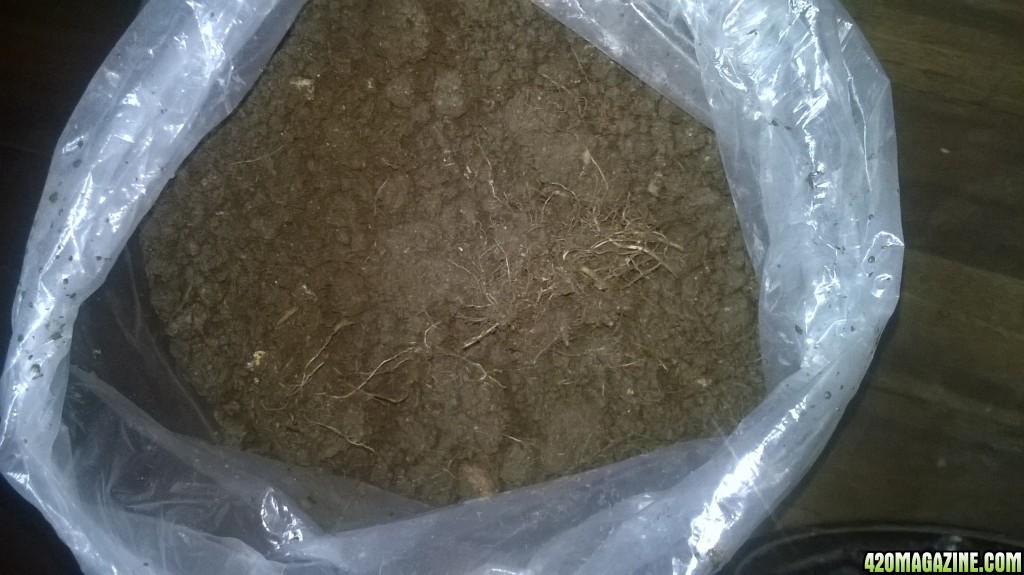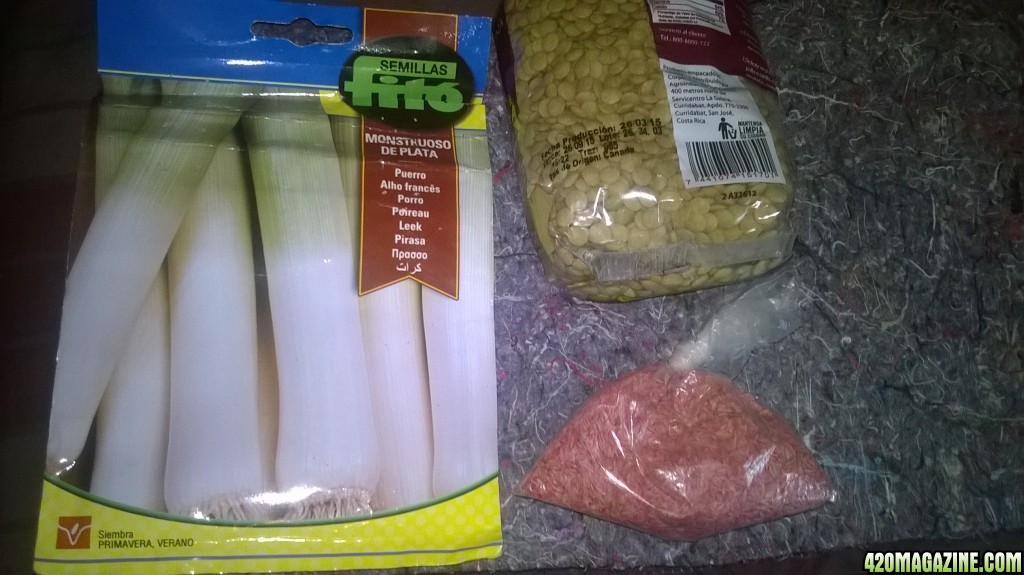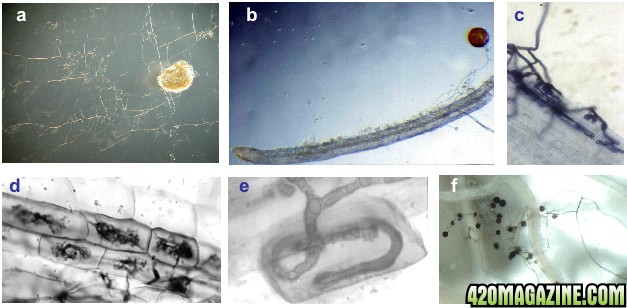TheRoach
Well-Known Member
There is this very detailed manual I would like to share, about the propagation of Mycorrhiza.
It is a fairly simple method involving the collection of naturally occurring mycorrhizae in you area, propagating the fungi in the roots of plants such as lentil and oats, or corn and beans (and many others), then killing the host plants to induce the Mycorrhiza fungi into producing spores; this soil loaded with spores becomes the inoculum for your new plants!
I am really exited to try this, I will make a tutorial and share my results!
Good thing is already have corn in the vegetable garden and would need to add lentils or beans only. I will also try to harvest the roots of other bushes and threes in my zone!
A SIMPLE METHOD FOR MAKING YOUR OWN MYCORRHIZAL INOCULUM
Mycorrhizal inoculum can be produced either in pots or in a ‘trap-trough’. The method is virtually the
same for both.
1. Collecting your ‘Starter Soil’
Where? Around 80% of vegetation forms mycorrhizal associations. The infected plant roots and the
spores and hyphae of the beneficial fungi are in the soil and can colonize new plants. In arid and
semi-arid regions you can be pretty sure of getting a good starter soil from any undisturbed area
containing native vegetation including most grown trees (except pines and oaks), woody shrubs and
perennial grasses.
In temperate regions, hedgerows, thickets and thriving perennial grasslands that have not been
cultivated recently are good sources. If you plan to use the inoculum with tree seedlings, there can be
special benefit in collecting some of the starter soil from under healthy trees of the same species.
Method: Clear away about 0.5m2
of the vegetation underneath your target plant. Dig down to a depth
of about 25cm collecting the soil and as many fine roots as possible. It is better, but not essential, to
collect from under several different trees and shrubs. With stony soil, sieve it to get rid of large stones.
2. Multiplying the mycorrhiza
To multiply the mycorrhiza from your starter soil we use a ‘trap-pot’. This method grows mycorrhizal
dependent annuals in the collected soil. These plants, often called “bait plants”, will become infected
with the mycorrhizal fungus causing the fungal population to multiply. Often two bait plant species are
grown together to encourage multiplication of different mycorrhizal fungal species.
A good combination would be a grassy species (eg maize, millet, sorghum, oats, wheat) or an allium
(onion, leek), with a species of legume (beans, peas, lentils, alfalfa, clover). Combining maize and
beans, for example, is a good choice as they grow well together. It depends, however, on what you
know to grow well in your area and on what you have available.
Where? The best place is in a site that will not be needed for at least three months and where you can
keep an eye on it. It will need regular watering, adequate light and protection from herbivores.
Method: Take your starter soil to the site you have chosen and then either fill one or several large (5
litre) plastic pots/basins (depending on how much inoculum you need). Alternatively, a trench can be
dug intothe ground and lined with the plastic sacks or other material available. This is what we call a
‘trap-trough’. The pit should be dug about 100cm x 50cm to a depth of 50cm and then lined with the
plastic sacks. Plastic sheeting, bin liners or sugar sacks will be fine.
Perforate the plastic to allow for drainage. Make sure that it covers the whole basin with an overlap.
Place stones on the overlap and fill the trough with the soil. Soak the seeds of your two chosen species
overnight. Plant them closer than normal, alternating the species.
4
Note: the soil that you dig out of the trench can be used to fill in the holes where you extracted soil from under the local vegetation.
How much inoculum do you want to make? This depends on what size container you will be planting
in, but estimate about 1/6 of each pot to be filled with the inoculum. If using on crops see ‘inoculating
crops’ below.
Trap Trough
3. Maintaining your trap-pots or trough
Once you have set up your trap-pot or trough you can more or less forget about it. Just keep it regularly
watered. In this time the roots of the bait plants will be developing and forming the association with
the mycorrhiza. Depending on the season you might need to shade it or protect it from frost. If growing
trap-pots then they can be moved into a more sheltered area.
4. Three months later…
Ten days before you are ready to use the inoculum, the bait plants should be cut down at the base of
their stem and watering should be stopped. This kills the plant, and tricks the fungus into producing
reproductive spores. Then, after the ten days, the inoculum is prepared by pulling up the roots of the
bait plants which should be chopped into roughly 1cm pieces and then mixed back into the soil from
the trap-pot or trough. This mixture of roots and soil is the inoculum.
5. Using the inoculum
The inoculum can be used on a wide range of different trees, shrubs, crops and garden plants. In all
cases the plants should be given the same care as normal. A small amount of compost will complement
the addition of mycorrhiza but no artificial fertilizers or herbicides should be added.
Inoculating:
(a) Inoculating trees, growing them from seed:
Method: As shown in the diagram below, two thirds of the pot or growing tube should be filled with
normal soil, with a little compost mixed in, if available. Then add a layer of inoculum and finally another
layer of normal soil into which the seed is sown. The inoculum layer need only be a couple of
centimetres deep. This means that when the roots grow down the tube they will come into contact with
the fungus, and quickly become infected. The trees are then cared for as usual, and planted out at the
same time as normal, to coincide with the growing season. The trees that have been infected with the
fungus should be much better equipped to cope with shortages in rainfall, and will also improve the
mycorrhizal potential of the surrounding soil.
(b) Inoculating pre-grown trees:
Method: dig the hole where you will plant your tree and throw in a spade-full of the inoculum. Place
the sapling in the hole and sprinkle a little more of the inoculum around the edges as you fill it in. If you
are adding compost then dig the hole slightly deeper, add the compost, cover over with normal soil and
then add the spade-full of inoculum.
(c) Inoculating crops:
Method: Put a pinch of inoculum into any hole that you are about to sow or plant into. Or mix a couple
of handfuls of the inoculum with seeds that you are about to sow and sow into a drill). If transplanting
then soak the root ball in water and then dip in the inoculum. The root ball will then have a coating of
inoculum. Plant as normal.
When you have used as much of the inoculum as you need, the trap-pot or trough can be topped up
again with more starter soil, re-planted with bait plants and the cycle repeated. This ensures that there
is a ready supply of inoculum all through the year.
You can download the full PDF by following the link in the title.
I hope we will soon have a tutorial with pictures!
Thank you for reading
It is a fairly simple method involving the collection of naturally occurring mycorrhizae in you area, propagating the fungi in the roots of plants such as lentil and oats, or corn and beans (and many others), then killing the host plants to induce the Mycorrhiza fungi into producing spores; this soil loaded with spores becomes the inoculum for your new plants!
I am really exited to try this, I will make a tutorial and share my results!
Good thing is already have corn in the vegetable garden and would need to add lentils or beans only. I will also try to harvest the roots of other bushes and threes in my zone!
A SIMPLE METHOD FOR MAKING YOUR OWN MYCORRHIZAL INOCULUM
Mycorrhizal inoculum can be produced either in pots or in a ‘trap-trough’. The method is virtually the
same for both.
1. Collecting your ‘Starter Soil’
Where? Around 80% of vegetation forms mycorrhizal associations. The infected plant roots and the
spores and hyphae of the beneficial fungi are in the soil and can colonize new plants. In arid and
semi-arid regions you can be pretty sure of getting a good starter soil from any undisturbed area
containing native vegetation including most grown trees (except pines and oaks), woody shrubs and
perennial grasses.
In temperate regions, hedgerows, thickets and thriving perennial grasslands that have not been
cultivated recently are good sources. If you plan to use the inoculum with tree seedlings, there can be
special benefit in collecting some of the starter soil from under healthy trees of the same species.
Method: Clear away about 0.5m2
of the vegetation underneath your target plant. Dig down to a depth
of about 25cm collecting the soil and as many fine roots as possible. It is better, but not essential, to
collect from under several different trees and shrubs. With stony soil, sieve it to get rid of large stones.
2. Multiplying the mycorrhiza
To multiply the mycorrhiza from your starter soil we use a ‘trap-pot’. This method grows mycorrhizal
dependent annuals in the collected soil. These plants, often called “bait plants”, will become infected
with the mycorrhizal fungus causing the fungal population to multiply. Often two bait plant species are
grown together to encourage multiplication of different mycorrhizal fungal species.
A good combination would be a grassy species (eg maize, millet, sorghum, oats, wheat) or an allium
(onion, leek), with a species of legume (beans, peas, lentils, alfalfa, clover). Combining maize and
beans, for example, is a good choice as they grow well together. It depends, however, on what you
know to grow well in your area and on what you have available.
Where? The best place is in a site that will not be needed for at least three months and where you can
keep an eye on it. It will need regular watering, adequate light and protection from herbivores.
Method: Take your starter soil to the site you have chosen and then either fill one or several large (5
litre) plastic pots/basins (depending on how much inoculum you need). Alternatively, a trench can be
dug intothe ground and lined with the plastic sacks or other material available. This is what we call a
‘trap-trough’. The pit should be dug about 100cm x 50cm to a depth of 50cm and then lined with the
plastic sacks. Plastic sheeting, bin liners or sugar sacks will be fine.
Perforate the plastic to allow for drainage. Make sure that it covers the whole basin with an overlap.
Place stones on the overlap and fill the trough with the soil. Soak the seeds of your two chosen species
overnight. Plant them closer than normal, alternating the species.
4
Note: the soil that you dig out of the trench can be used to fill in the holes where you extracted soil from under the local vegetation.
How much inoculum do you want to make? This depends on what size container you will be planting
in, but estimate about 1/6 of each pot to be filled with the inoculum. If using on crops see ‘inoculating
crops’ below.
Trap Trough
3. Maintaining your trap-pots or trough
Once you have set up your trap-pot or trough you can more or less forget about it. Just keep it regularly
watered. In this time the roots of the bait plants will be developing and forming the association with
the mycorrhiza. Depending on the season you might need to shade it or protect it from frost. If growing
trap-pots then they can be moved into a more sheltered area.
4. Three months later…
Ten days before you are ready to use the inoculum, the bait plants should be cut down at the base of
their stem and watering should be stopped. This kills the plant, and tricks the fungus into producing
reproductive spores. Then, after the ten days, the inoculum is prepared by pulling up the roots of the
bait plants which should be chopped into roughly 1cm pieces and then mixed back into the soil from
the trap-pot or trough. This mixture of roots and soil is the inoculum.
5. Using the inoculum
The inoculum can be used on a wide range of different trees, shrubs, crops and garden plants. In all
cases the plants should be given the same care as normal. A small amount of compost will complement
the addition of mycorrhiza but no artificial fertilizers or herbicides should be added.
Inoculating:
(a) Inoculating trees, growing them from seed:
Method: As shown in the diagram below, two thirds of the pot or growing tube should be filled with
normal soil, with a little compost mixed in, if available. Then add a layer of inoculum and finally another
layer of normal soil into which the seed is sown. The inoculum layer need only be a couple of
centimetres deep. This means that when the roots grow down the tube they will come into contact with
the fungus, and quickly become infected. The trees are then cared for as usual, and planted out at the
same time as normal, to coincide with the growing season. The trees that have been infected with the
fungus should be much better equipped to cope with shortages in rainfall, and will also improve the
mycorrhizal potential of the surrounding soil.
(b) Inoculating pre-grown trees:
Method: dig the hole where you will plant your tree and throw in a spade-full of the inoculum. Place
the sapling in the hole and sprinkle a little more of the inoculum around the edges as you fill it in. If you
are adding compost then dig the hole slightly deeper, add the compost, cover over with normal soil and
then add the spade-full of inoculum.
(c) Inoculating crops:
Method: Put a pinch of inoculum into any hole that you are about to sow or plant into. Or mix a couple
of handfuls of the inoculum with seeds that you are about to sow and sow into a drill). If transplanting
then soak the root ball in water and then dip in the inoculum. The root ball will then have a coating of
inoculum. Plant as normal.
When you have used as much of the inoculum as you need, the trap-pot or trough can be topped up
again with more starter soil, re-planted with bait plants and the cycle repeated. This ensures that there
is a ready supply of inoculum all through the year.
You can download the full PDF by following the link in the title.
I hope we will soon have a tutorial with pictures!
Thank you for reading










